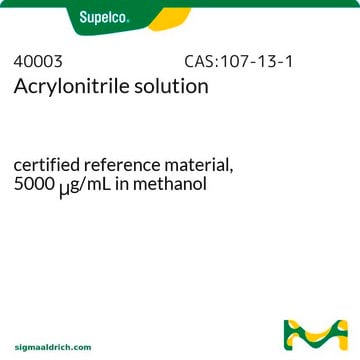8.00834
Acrylonitrile
(stabilised with hydroquinone monomethyl ether) for synthesis
Sinónimos:
Acrylonitrile, Acrylic acid nitrile, Vinyl cyanide
About This Item
Productos recomendados
vapor pressure
124 hPa ( 20 °C)
Quality Level
assay
≥99% (GC)
form
liquid
autoignition temp.
480 °C
potency
78 mg/kg LD50, oral (Rat)
expl. lim.
2.8-28 % (v/v)
pH
6.0-7.5 (20 °C, 50 g/L in H2O)
bp
77.3 °C/1013 hPa
mp
-83.55 °C
transition temp
flash point -4.4 °C
density
0.81 g/cm3 at 20 °C
storage temp.
2-8°C
InChI
1S/C3H3N/c1-2-3-4/h2H,1H2
InChI key
NLHHRLWOUZZQLW-UHFFFAOYSA-N
Application
- Designing amphipathic surfaces: The use of interfacial energy in photopolymerization processes for creating amphipathic surfaces, enhancing applications in coatings and biomedical devices using acrylonitrile polymers (Curley et al., 2024).
- Dental model printing technology: Atwal and Bhatnagar assessed the flexural strength of dental models fabricated using various 3D printing technologies, including those utilizing acrylonitrile-based resins, highlighting differences in mechanical properties (Atwal and Bhatnagar, 2024).
- Rubber composite enhancements: Kruželák et al. examined the electrical conductivity, EMI absorption, and mechanical properties of rubber composites, incorporating acrylonitrile to improve performance in industrial applications (Kruželák et al., 2024).
- Biopolymer blend characterization: Akbarian-Saravi et al. characterized the mechanical and biodegradation properties of NBR/biopolymer blends, with acrylonitrile enhancing the blend′s performance in various industrial and environmental applications (Akbarian-Saravi et al., 2024).
- Electrode/electrolyte interface regulation: Chen et al. discussed constructing polymer molecules to regulate the electrode/electrolyte interface in lithium-metal batteries, utilizing acrylonitrile derivatives to enhance battery performance (Chen et al., 2024).
Analysis Note
Density (d 20 °C/ 4 °C): 0.805 - 0.807
Water (K. F.): ≤ 1.0 %
Identity (IR): passes test
signalword
Danger
Hazard Classifications
Acute Tox. 3 Dermal - Acute Tox. 3 Inhalation - Acute Tox. 3 Oral - Aquatic Chronic 2 - Carc. 1B - Eye Dam. 1 - Flam. Liq. 2 - Skin Irrit. 2 - Skin Sens. 1B - STOT SE 3
target_organs
Respiratory system
Storage Class
3 - Flammable liquids
wgk_germany
WGK 3
flash_point_f
23.0 °F - closed cup
flash_point_c
-5 °C - closed cup
Certificados de análisis (COA)
Busque Certificados de análisis (COA) introduciendo el número de lote del producto. Los números de lote se encuentran en la etiqueta del producto después de las palabras «Lot» o «Batch»
¿Ya tiene este producto?
Encuentre la documentación para los productos que ha comprado recientemente en la Biblioteca de documentos.
Los clientes también vieron
Nuestro equipo de científicos tiene experiencia en todas las áreas de investigación: Ciencias de la vida, Ciencia de los materiales, Síntesis química, Cromatografía, Analítica y muchas otras.
Póngase en contacto con el Servicio técnico














